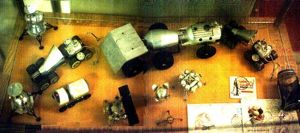TMK-E (original) (raw)

Home - Search - Browse - Alphabetic Index: 0- 1- 2- 3- 4- 5- 6- 7- 8- 9
A- B- C- D- E- F- G- H- I- J- K- L- M- N- O- P- Q- R- S- T- U- V- W- X- Y- Z
TMK-E
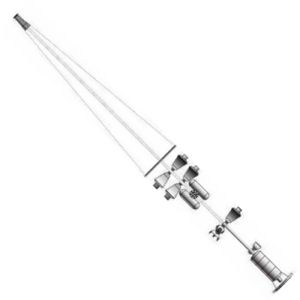
TMK-E
Final design of TMK-E spacecraft
Credit: © Mark Wade
Russian manned Mars expedition. Study 1960. Feoktistov felt that the TMK-1 manned Mars flyby design was too limited. His design group proposed in 1960 a complete Mars landing expedition, to be assembled in earth orbit using two or more N1 launches.
Status: Study 1960. Thrust: 74 N (17 lbf). Gross mass: 150,000 kg (330,000 lb). Specific impulse: 10,000 s. Height: 175.00 m (574.00 ft). Span: 20.00 m (65.00 ft).
The spacecraft would be powered by nuclear electric engines, with the reactor moved away from the crew quarters on long telescoping booms. Five landers would deliver a nuclear-powered 'Mars Train' on the surface for a one-year survey of the terrain. The design would be heavily modified as the 1960's progressed, as research showed the Martian atmosphere to be much thinner and the nuclear electric engines to be less efficient than assumed.
Feoktistov's section of OKB-1 felt that the Maksimov TMK-1 design was too limited and optimistic. They concluded that it would not be possible or advisable to produce a single-launch spacecraft. At first they proposed a dual-launch scenario, with the TMK being launched into low earth orbit and going through a long period of systems proving and test. Only after the spacecraft had completed this 'shakedown cruise' would a second N1 launch would put the trans-Mars injection stage into orbit to propel the spacecraft toward Mars.
But Feoktistov was already studying ion engines as a means of either increasing the flight mass of the TMK or reducing the number of launches to get the spacecraft going toward Mars. OKB-1 Section 12, led by M V Melnikov, had already started development of such an engine in 1957 at the urging of S P Korolev. Their 7.5 kgf thrust ion engine design could take the TMK-E on a low acceleration spiraling trajectory away from the Earth until it finally reached escape velocity and headed toward Mars. However to power the engine would require solar panels with a total area of 36,000 square meters - clearly beyond 1959 technology. Feoktistov's solution was to turn to the use of a nuclear reactor to power the ion engine.
Feoktistov's TMK-E became the first project for an expedition to Mars in a spacecraft propelled by nuclear reactor-powered ion engines. The craft would be assembled in near-earth orbit and from there launched toward Mars with a crew of six. The spacecraft as initially designed used a 7 MWt nuclear reactor to power the 7.5 kgf ion engine, which had a predicted specific impulse of 10,000 seconds. The TMK-E would be capable of a three year flight to Mars and return, of which one year was powered flight. From fore to aft the 175 m long spacecraft consisted of:
A stretched 6 m diameter, 18 m long TMK-1 living section with a shield at the nose, to accommodate a total crew of six
A small diameter pressurized tunnel to which were docked the two crew-return Mars landing craft and a Soyuz-type earth return capsule
A long lattice boom, along which was first encountered, at the center of gravity of the spacecraft, the ion engine cluster and propellant tanks
Four further Mars landing craft, containing the rest of the 'Mars Train' surface vehicles
A large diameter radiation shield to protect the crewed areas from the reactor
At the end of the lattice boom, deployed after launch and stabilized by two telescoping struts, the power reactor
The year-long surface expedition would assemble a 'Mars Train' from five separately-landed components. The landing craft, weighing about 10 metric tons each, were conical aeroshells with a blunt base, 5.5 m in diameter and 9 m in height. On the surface the shell would separate and a section of it would provide a carapace for the surface vehicles within. The Mars Train itself would consist of five coupled wagons:
Forward wagon with crew cabin, manipulator arms and a drilling system
Launch wagon with a platform for a convertiplane (vertical takeoff/horizontal flight) for flying in the Martian atmosphere
Two wagons with rocket launch platforms. Either rocket (one a spare) could be used for landing the three-man surface crew and returning to dock with the main spacecraft in near-Mars orbit. The landers themselves were four-legged truncated cones, 5.4 m tall and 7 m across the landing gear.
Aft wagon with a nuclear reactor to power the train
Following assembly of the train on the surface, the crew would begin their long research of the surface and atmosphere of the red planet. They would make a complete traverse of the planet, from pole to pole. Data would be transmitted from the surface to the crew in the spacecraft in its Mars orbit and then retransmitted to Earth. After completing their work, the crew, together with samples of soil and other research results would return to the TMK-E in near-Mars orbit, and from there to the earth.
Those who worked on this project included K P Feoktistov, V A Adamovich, V V Mologtsov, K S Shustin, V E Lubinskiy, V I Staroverov, L A Gorshkov, and Ts V Solovyov. Feoktistov was OKB-1's premier manned spacecraft designer and would fly in space on Voskhod 1.
TMK-1 Mission Summary:Summary: First Soviet study for a manned Mars flyby; set payload requirement for N1 booster
Propulsion: LOX/Kerosene
Braking at Mars: flyby
Mission Type: Crocco
Split or All-Up: all up
ISRU: flyby
Launch Year: 1971
Crew: 2
Outbound time-days: 315
Mars Stay Time-days: 0
Return Time-days: 780
Total Mission Time-days: 1095
Total Payload Required in Low Earth Orbit-metric tons: 75
Total Propellant Required-metric tons: 45
Propellant Fraction: 0.60
Mass per crew-metric tons: 37
Launch Vehicle Payload to LEO-metric tons: 75
Number of Launches Required to Assemble Payload in Low Earth Orbit: 1
Launch Vehicle: N1
Crew Size: 6. Electric System: 7,000.00 average kW.
Family: Mars Expeditions. Country: Russia. Launch Vehicles: Mars tactical rocket, N1, N1 1969. Propellants: Electric/Xenon. Agency: Korolev bureau. Bibliography: 206, 283, 376, 89.
Photo Gallery
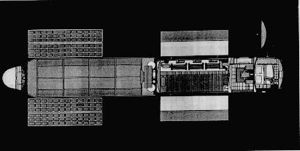 |
TMK-E CutawayCutaway drawing of an early version of the TMK-E spacecraftCredit: Gleb Aleksushin |
|---|
 |
TMK Mars LanderSeparation of Mars lander from an early version of the Soviet TMK-E Manned Mars expedition spacecraft.Credit: Gleb Aleksushin |
|---|
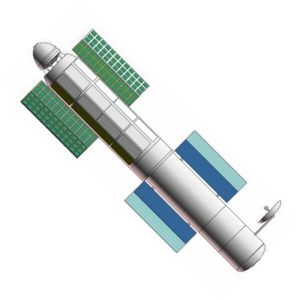 |
TMK-1Early design of TMK-E spacecraft.Credit: © Mark Wade |
|---|
 |
Nucear electric shipNuclear electric spacecraftCredit: © Mark Wade |
|---|
 |
TMK-ERKK Energia drawing of TMK-ECredit: RKK Energia |
|---|
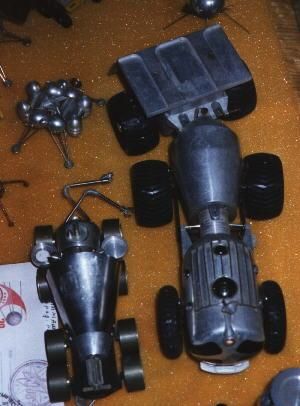 |
MarsokhodNuclear powered crewed Mars Train rover (with ascent stage to orbit in centre).Credit: Andy Salmon |
|---|

